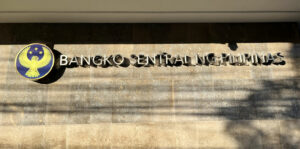




Philippines Trade Update: Trade trajectories trend along
 DOWNLOAD
DOWNLOAD

Policy Rate Updates: Double cut finale
 DOWNLOAD
DOWNLOAD

Monthly Economic Update: One for the road
 DOWNLOAD
DOWNLOAD


BSP seen to keep rates unchanged at Dec. meeting

The Bangko Sentral ng Pilipinas (BSP) may continue to keep borrowing costs at a 16-year high of 6.5% at its last policy meeting next month, analysts said.
Security Bank Corp. Chief Economist Robert Dan J. Roces said easing global rice and oil prices have given the BSP more flexibility to pause at last week’s meeting.
The BSP kept its key policy rate unchanged at the Nov. 16 meeting, following the 25-basis-point (bp) off-cycle rate hike on Oct. 26.
“Despite this, the BSP maintains a hawkish stance, emphasizing the likelihood of rising inflation and indicating readiness to increase rates, if necessary,” he said in a Viber message.
“We expect the BSP to maintain a hawkish pause of the policy rate at 6.5% in its final meeting,” he said, referring to the Monetary Board’s Dec. 14 meeting.
But the higher-than-expected growth in the third quarter gave the central bank room to further tighten in case inflationary pressures flare up, Mr. Roces added.
Ryota Abe, an economist at Sumitomo Mitsui Banking Corp. (SMBC), said the BSP may keep rates steady at the Dec. 14 meeting.
“The cumulative effect of past rate hikes has had an impact on the economy, and maintaining the current policy rate will gradually increase its effectiveness,” he said in a note.
Since inflation has been stabilizing lately, Mr. Abe said there are concerns about “the adverse effects on the domestic economy.”
The Philippine economy grew by 5.9% in the third quarter from 4.3% seen a quarter ago. Still, this is slower than the 7.7% growth in the third quarter of 2022.
In the first nine months of the year, growth averaged 5.5%, still below the 6-7% full-year target of the government.
While the BSP has maintained its future policy decisions will be data-dependent, Mr. Abe noted the focus has shifted towards the economy. The BSP’s next move would depend on the November inflation data, which will be released on Dec. 5.
“Consumers’ sense of high prices has not yet been resolved, and the risk of further stickiness of inflation cannot be ignored as upward price pressures arising from supply-side factors trigger secondary price increases, which is what BSP fears. BSP has no choice but to continue its hawkish monetary policy for the time being,” he said.
Inflation fell to a three-month low of 4.9% in October from 6.1% in September and 7.7% in the same month a year ago. Still, inflation went above the BSP’s 2-4% target band for the 19th straight month. Year to date, inflation stood at 6.4%.
Meanwhile, Euben Paracuelles, senior economist at Nomura Global Markets Research, said the key rate may remain unchanged at 6.5% over the next several months.
“This is supported by our forecast that inflation will decline to 3.8% in 2024 from 6.2% in 2023,” he said.
“However, because of the uncertainty and various factors contributing to inflation risks, we think BSP will continue to err on the side of caution and maintain its hawkish rhetoric for a while, still pledging that it remains ready to resume hiking as needed,” he added.
At its last meeting, the BSP lowered its risk-adjusted inflation forecast for 2023 to 6.1% (from 6.2% in October), to 4.4% (from 4.7%) for 2024, and to 3.4% (from 3.5%) for 2025.
The BSP raised its baseline inflation forecast to 6% in 2023 (from 5.8% in September) and to 3.7% in 2024 (from 3.5%), but trimmed its 2025 inflation estimate to 3.2% (from 3.4%).
On the other hand, the Philippine central bank could still tighten monetary policy one more time before the year ends.
ANZ Research said despite the policy pause on Thursday, the BSP kept its tightening bias and left the door open for more rate hikes this year.
“Our current policy rate forecasts continue to reflect a 25-bp hike at the December meeting and a hold at least until end-2024,” ANZ said in a note authored by economists Debalika Sarkar and Sanjay Mathur.
“We will, however, revisit our forecasts after the release of the November 2023 inflation print in early December,” it added.
In a note, Citi economist for the Philippines Nalin Chutchotitham said the BSP may still hike by 25 bps to 6.75% this year to anchor inflation expectations.
“We still see potential increases in electricity fares leading to higher costs on goods, while the strong employment and wage hikes likely continue to support robust domestic demand expansion,” she said.
Ms. Chutchotitham also sees no rate cut in the first half of 2024. — By Keisha B. Ta-asan, Reporter
This article originally appeared on bworldonline.com





 By BusinessWorld
By BusinessWorld